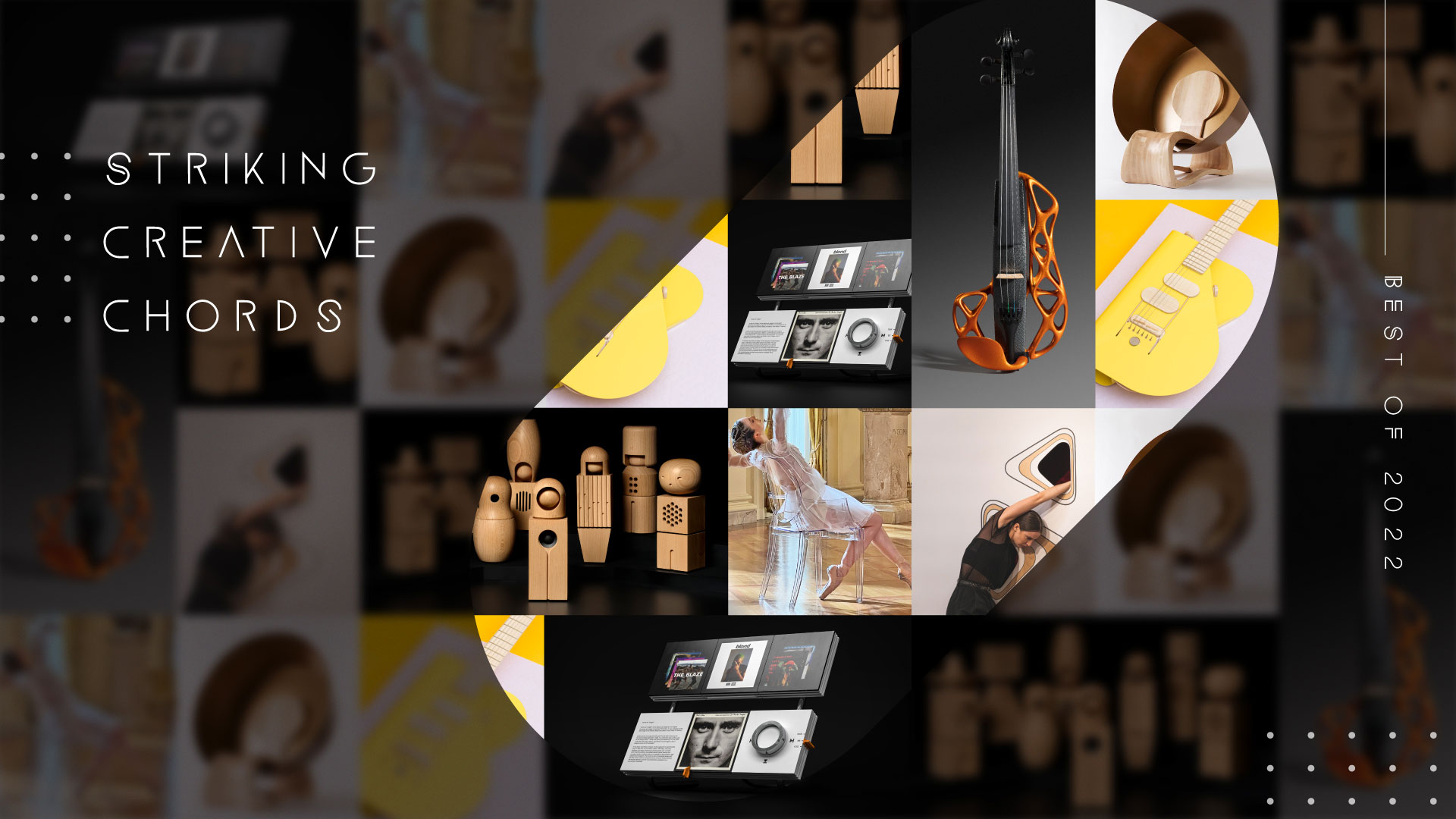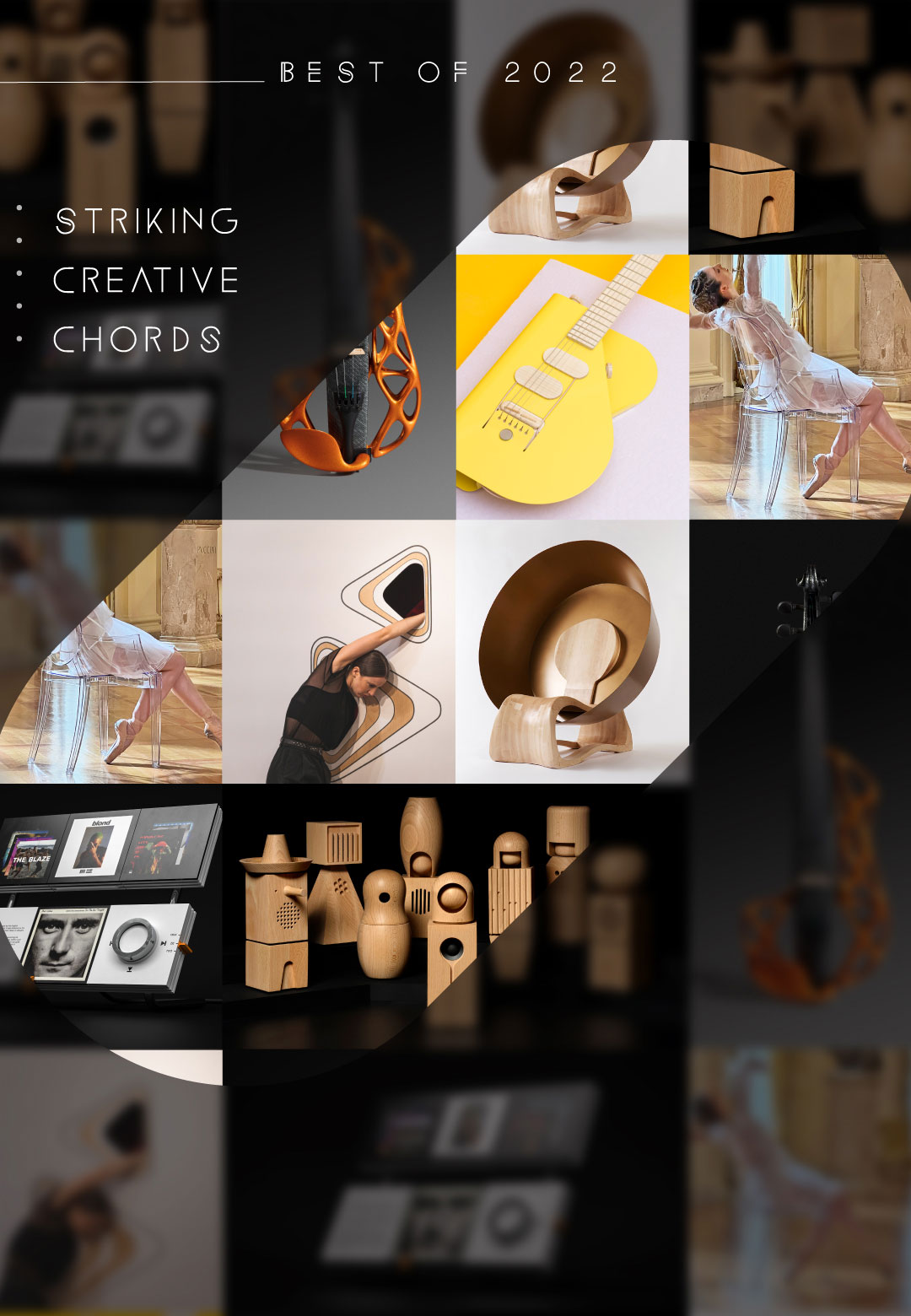Greek philosopher Plato aptly said, “Music gives a soul to the universe, wings to the mind, flight to the imagination, and life to everything.” From cultures and languages to nationalities and generations, there is hardly any barrier that music does not transcend. Wafting threads of melodies and harmonies sew fissures of differences, backgrounds, and prejudices that humans often create for and between themselves. As eras perpetually change, and the world and its communities evolve, the ubiquitous love for music prevails, and understandably so.
Melodious sounds undeniably guide artists and musicians who work closely with them, but also so many more. From innovative musical instruments to evolving music technology, countless instances of compositions inspired by music—or realised as an ode to it—reverberated in the world of design. Looking back at Best of 2022, STIR collates the musical creations that made heads turn and feet waltz in the creative community and beyond.
Choir by Teenage Engineering
Melodious voices echoing through church halls: how often does one wish that this invigorating experience could be carried home. Right in time for Christmas, Sweden-based electronics company Teenage Engineering plays Santa and launches the portable musical ensemble: Choir. Drawing inspiration from the company’s very first project, the Absolut Choir—an art installation that debuted in 2007 as a set of 22 wooden dolls of varying sizes for the larger ‘absolute machine’ project—the Choir comprising eight wooden dolls sing in perfect harmony, emulating an actual church choir. From a repertoire spanning baroque to folk, the little singers can even present the user’s own compositions via the company’s OP-1 Field, OP-Z, or any Bluetooth MIDI keyboard—conducting the choir to instantly sing any note that is played. The eight dolls do not just present different vocal ranges, but also embody different cultures from across the globe—a feature that further contributes to the intrigue.
Goyo Chair by Lee Ye Chan
A primitive epitome of sound therapy, Tibetan singing bowls have aided healing for over 6,000 years—producing soft vibrations that course through the palm holding the bowl and throughout the body. While countless industrial designers endeavour to employ sound therapy as a design device in products and functional objects, what would possibly entail when a chair by assumes the form of the age-old meditative object and helms the process of therapeutic healing? Korean designer Lee Ye Chan reinterprets a chair design as a contemporary garb for meditation. Emulating traditional Tibetan singing bowls, the Goyo chair is designed as a human-centric singing bowl that produces quiet, healing sounds when struck on its metal shell.
SilenceTop by Reina Suyeon Mun
Albeit spoken social interactions are deemed essential for a content social life, revelatory silences have a comparable—if not more important—role to play in expression. When caesura and ellipses are praised for being poetic tools of silence, In the contemporary world where gazes are glued to blue screens and silence predominates, can poetic pauses be abandoned and conversations be imposed through musical interventions? This coffee table by Korean Interdisciplinary designer Reina Suyeon Mun aims to dictate the awkward pauses in social interactions. The 'SilenceTop' low table designis conceived as an interactive microarchitectural item that confronts silence in difficult contexts by plucking semitones on a kalimba.
Celebrating 20 years of Louis Ghost
A mutual quest of abstracting arresting sceneries and inspiring concepts into art, performance, and design, united four collaborators with diverse stylistic languages and from distinct locations to celebrate the 20th anniversary of Louis Ghost, a contemporary reinterpretation of the famous Louis XV chair by French designer Philippe Starck. Louis Ghost, designed by Starck for the Italian furniture brand Kartell, is a transparent chair that stirred the status quo when it was launched in 2002. Following this trend of challenging conventions, Kartell joined forces with the Milanese opera house Teatro alla Scala to realise a tribute—with dance and music—to the chair that completed 20 years.
Tiles: a unique analogue music experience
With any song in the world merely a click away, modern music listening has morphed into thoughtless consumption sans excitement or eagerness in its process. A tangible interface that revives the analogue process of experiencing music will aid not only a deeper engagement with our music repertoire but also the anticipation of putting on our favourite tracks. With an interdisciplinary team of interaction and industrial designers, Kay van den Aker, Oscar Olsson, Emile Chuffart and Tobias Ertel bring to light their interactive sound design project ‘Tiles’ that poses as an ingenious solution to the absence of character with a hands-on and experience-oriented prototyping focus.
Karen Ultralight by Anima Design for Katahashi Instruments
Karen is a bold skeletal violin aspiring to shake the music industry to the bone. Relinquishing the hackneyed wooden acoustic chambers with its sleek futuristic frame, Karen Ultralight is an electric violin that one cannot miss. Barcelona-based product design and development agency Anima Design concocted this innovative music technology for Japanese violin makers Katahashi Instruments. Using computational design systems, the violin’s ultralight structure is calculated at an exemplary ergonomic and acoustic level. “This project was a challenge because we haven’t made any sketches and we design directly with mathematical formulas crossing data from weight, ergonomics and we were defining shapes on the screen in real-time,” says Diego Quiroga, product designer and CEO of Anima Design.
Cosmo by Verso Musical Instruments
“Nothing is more beautiful than a guitar, except, possibly, two,” Frédéric Chopin, iconic Polish composer and virtuoso pianist, once said. The beloved electric guitar, the most sought-after musical instrument of the 1950s and 1960s, experienced a resurgence with Verso Musical Instruments’ Cosmo—a new- age electric guitar salvaging its fading relevance. Based in Kassel, Germany, the boutique company headed by industrial designer Robin Stummvoll, unveiled a unique guitar design with a sleek and minimal sheet metal body. Stepping away from the cliched wooden body, the German designer went on to strip down the arrangement of the instrument to the bare minimum, fuelled by bare necessities in lieu of aesthetics. Using simplified processes and experimenting with materials considered incompetent for building musical instruments, Stummvoll crafted a clean, versatile, and innovative silhouette for Cosmo.
TX-6 by Teenage Engineering
Teenage Engineering, with its roster of stylish synthesisers, speakers and PC cases, added another innovative design to its oeuvre, but with a dash of surprise. A compact pro-mixer that fits the palm of your hand and encapsulates a six-channel stereo mixer with built-in equaliser, compressor and digital effects and can also be used as a multi-functional USB audio interface no less emerges as a game-changer in the realm of sound design. The company shatters the long-established image of a chunky field mixer by packing all of these functions and more into their tiny, hand-held audio gadget, the TX-6, the first portable pro-mixer that can be used as a multi-functional 32-bit 48kHz audio interface: the smallest of its kind. On a par with the larger counterparts in the market, this sturdy little invention is a bundle of unparalleled technology.
‘Sumida toy piano’ collection by Yamaha design laboratory x Chiba University’s department of design
Yamaha design laboratory in collaboration with Chiba University’s department of design came forth with an assortment that is focused on preserving the past. Their latest ‘Sumida toy piano’ collection reinterprets Japanese cultural values by presenting old furniture designs as pianos. The product design collection encompassing three toy pianos was displayed in Yamaha’s Ginza shop in Tokyo. For over 170 years, Yamaha has been a pioneering contributor to the popularisation of western music and instrumental culture in Japan. However, with the increasingly overlooked cultural and traditional values of Japan, Yamaha focused the spotlight on ancient Japanese values, reintroducing them to the new generation.
Perimeters by Naama Tsabar
Israeli born and New York based artist Naama Tsabar’s site-specific work took stage at The Bass Museum of Art. Revolving around the artist’s series Inversions, ‘Perimeters’ invited visitors to engage and interact with the installations. Tsabar infused elements from sculpture, music, and performance into the architecture, transforming the museum itself into an instrument. The interactive exhibition presented new iterations of four bodies of work that the artist has explored since 2006. Tsabar explored the movement of sound through and beyond walls and built environments, working at the point of union of architecture and music. Through the exhibition, the artist challenged the viewers’ rigid perceptions of sound, sculpture, and the museum as a space.






 Sign in with email
Sign in with email










What do you think?